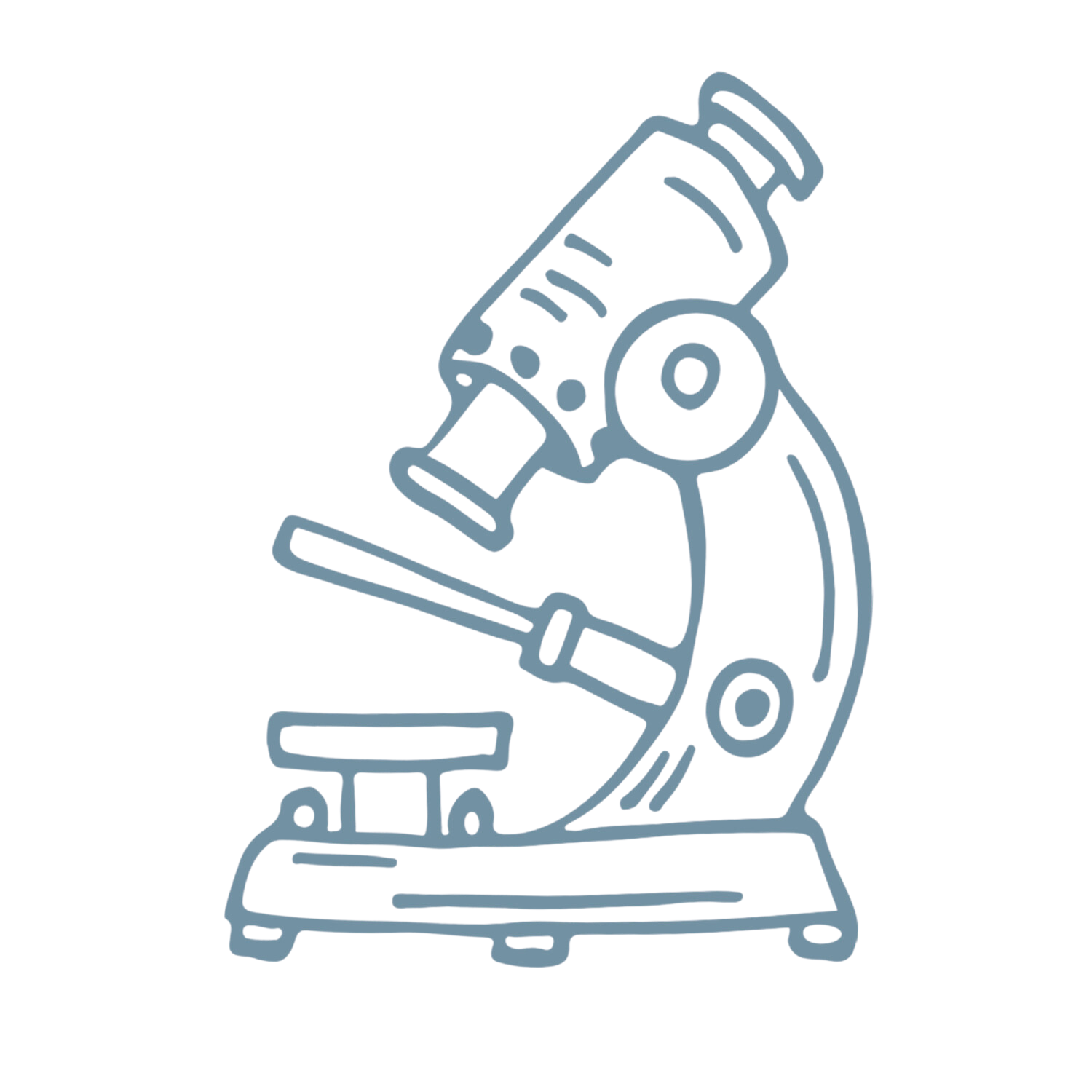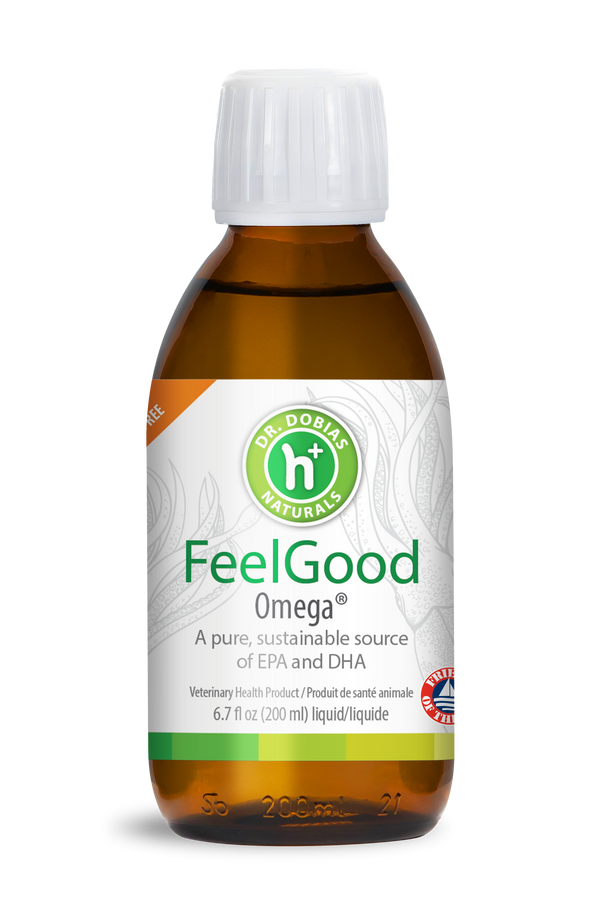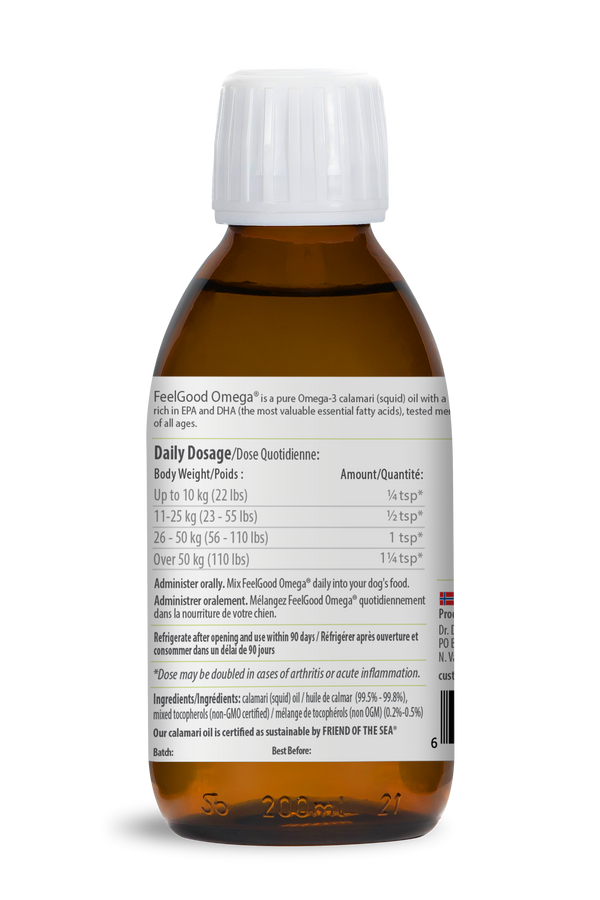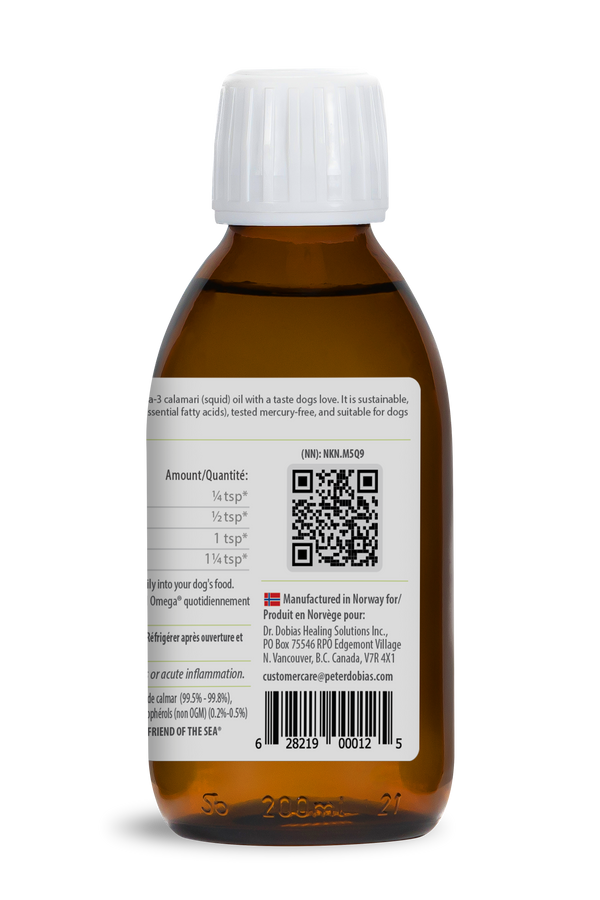FeelGood Omega®
$44.99 CAD /Lifetime 100% Money Back Guarantee
Try it risk-free
If you are not completely satisfied for any reason at any time, we'll refund your purchase
Save on all dog essentials
Mix & Match!
Buy any 4 products and save 15% * When you purchase multiples of the same or varied products
Ingredients
Calamari (Squid) Oil (99.8%)Mixed Tocopherols (non-GMO certified) (0.2 - 0.5%) Nutritional Analysis (per tsp):
|
Calories |
42 |
|
|
|
|
% DV |
|
Total Fat |
4.5g |
7% |
|
• Saturated |
1g |
4% |
|
• Monounsaturated |
1360mg |
|
|
• Polyunsaturated |
1950mg |
|
|
◦ Omega-3 |
1450mg |
|
|
◦ EPA |
≥ 410mg |
|
|
◦ DHA |
≥ 920mg |
|
|
Cholesterol |
70mg |
23% |
|
Sodium |
0mg |
0% |
|
Total Carbohydrate |
0g |
0% |
|
• Dietary Fiber |
0g |
0% |
|
• Total Sugars |
0g |
0% |
|
Protein |
0g |
0% |
Not a significant source of vitamin D, calcium, iron or potassium.%DV based on a 2,000 calorie diet.






The FeelGood Omega Story
The FeelGood Omega Story
“How we sourced the highest quality EFA’s.”
When my team and I embarked on our journey to find the best quality source of omega fatty acids (EFAs) we didn’t know how hard the journey would be. We navigated the sea of different sources and made many discoveries. This is why we don’t use fish, krill and algae oils.
We had to take into consideration that fish is no longer sustainable because of overfishing, plus mercury and radioactive pollution is now an issue.
Krill is a primary source of food for fish and marine mammals. Pretty much all marine life depends in one way or another on krill supply. Excessive commercial krill harvesting currently threatens all marine life.
We were disappointed to find out that algae-based EFAs are produced with GMO (Genetically Modified Organisms), which we do not use in our products. Our main concern is that the long term effect of GMO on nature is unknown. Also, algae oils are extracted using methyl alcohol, which is toxic.

Flax seed oil and other plant oils only contain ALA (alpha linolenic acid), a short chain EFA that does not have the same benefits as EPA and DHA. Dogs and people do not convert ALA to long chain fatty acids well, therefore plant oils are not an adequate source of EPA and DHA.

The main reason why we didn’t choose phytoplankton is that it produces large quantities of dimethyl sulphate, which is a toxic, carcinogenic, and teratogenic substance (it affects fetal development).
The population has been rising since 1950’s due to decrease in fish, their natural predator. It is low on the food chain and micro filtered to ensure it is free of mercury and heavy metals. Most of all, it is rich in EPA and DHA, the most valuable EFA’s.
Why Calamari is the best Omega-3 source

How is Calamari [squid] different?

How is Calamari [squid] different?
Over-fishing of our oceans is a serious problem and we need to be responsible by reducing fish consumption. Mercury accumulation and radioactive pollution in fish is also a serious problem.
Research has shown that the squid population has been on the rise since the 1950’ s which may be a result of climate change and a decrease in the numbers of squid-eating fish.
The great news is that squid is an incredibly rich source of EPA and DHA – the most valuable EFAs [Omega-3]. Calamari also lacks bones and it is low on the food chain, which makes it non-toxic and safe.

Safety & Testing
There are several steps that we take to make sure that FeelGood Omega is safe and toxin free.
- Micro-filtered to ensure no heavy metals or toxins.
- Tested for EPA and DHA content to ensure top quality.
- Lab tested for toxins and heavy metals.
- We perform additional batch testing to confirm results.
The great news is that squid is an incredibly rich source of EPA and DHA – the most valuable EFAs [Omega-3]. Calamari also lacks bones and it is low on the food chain, which makes it non-toxic and safe.
To summarize, squid oil is the omega-3 winner. It is not only nutritionally comparable with the best sources of omega oil but it is also a ‘feel-good oil’ because its production does not deplete or disturb the natural food chain.
What you need to know about Omegas EPA and DHA
Omega oils can be sourced from either plants or marine animals. Nutritionally, the most valuable omega oils are Eicosapentaenoic (EPA) and Docosahexaenoic acid (DHA).
DHA is great for the skin and coat as well as nervous system function, which can be very beneficial for young developing puppies, adult dogs and senior dogs for preventing senior dog dementia.
EPA is the anti-inflammatory component of omega oils so if your dog has joint issues, all you need to do is to increase the overall dose.
Squid has a perfect balance of EPA and DHA and research confirms that the right omega oils have a very comparable anti-inflammatory effect to NSAID’ s (non-steroidal anti-inflammatory drugs), without the serious side-effects.
Omega 3, 6 Or 9. Which One Is The Most Important?

Omega 3, 6 Or 9. Which One Is The Most Important?
Omega-3, especially EPA and DHA, must be your focus to maintain health & longevity!
Omega-6 is already a very common component of meat, eggs, grains, nuts and seeds.
Omega-9s can be produced by the body naturally and they’re also a common component of animal fat and vegetable oils.
Omega-3 is essential for optimum health in canines and people

Omega-3 is essential for optimum health in canines and people
They are almost always deficient in both, domestic animals and people. This group of essential fatty acids [EFAs] is the most valuable when it comes to maintaining health.
Omega-3 has very potent anti-inflammatory agents and they are the key building blocks to a healthy healing response. In my experience and as recent studies show, dogs do not get enough omega-3 in their diet for optimal health and that is why they need to be supplemented.
It helps boost the hair growth, brain function, healthy aging, skin & coat health, reproductive health and joint health.
Why FeelGood Omega-3?

When you are looking for an omega supplement for yourself, your children, or your animal friends, omega-3 fatty acids should be your main focus. When we embarked on the search for safe omega oils in 2015, I had no idea how long and hard the journey would be, but it also taught us how to source quality omega-3 to keep your dog safe and in peak condition.
How do we compare to other leading omega oil brands?

How do we compare to other leading omega oil brands?
We strive to carry the most complete, toxin free, and sustainable Omega oil on the market. Since FeelGood Omega is an extremely pure Omega-3 oil, it is also the most cost-effective Omega-3 oil p/gram currently available.
Canine Serving Size Details
|
|
LESS THAN 22LBS | 23LBS – 55LBS | 56LBS – 110LBS | +110LBS |
|---|---|---|---|---|
|
Serving size |
1/4 tsp (1.25ml) |
1/2 tsp (2.5ml) |
1 tsp (5ml) |
1 1/4 tsp (6.25ml) |
|
Servings p/bottle |
160 days |
80 days |
40 days |
32 days |
* Each bottle has a 2 year shelf life. Freshest if used within 90 days
Administration

Administration
Daily Dosage Recommendation:
FeelGood Omega should be added daily to any natural raw, cooked or processed food. Dosage can be split between two meals or given all at once.
- Up to 10 kg (22 lbs) – 1/4 tsp daily – Will last approx. 160 days (but is freshest if used within 90 days)
- 11 – 25 kg (23 – 55 lbs) – 1/2 tsp daily – Will last approx. 80 days
- 26 – 50 kg (56 – 110 lbs) – 1 tsp daily – Will last approx. 40 days
- Over 50 kg (110 lbs) – 1 1/4 tsp daily – Will last approx. 32 days
* Dogs less than 22 lbs can still have 1/4 tsp of FeelGood Omega because smaller dogs usually have faster metabolic rates and higher energy demands.
** Dosage can be doubled in the case of arthritis or acute inflammation
Must be refrigerated after opening and used within 90 days for maximum freshness and stability.
Best when used together with GreenMin®, SoulFood® and GutSense®.
Customer Reviews
Write a reviewSort by
Filter by topic
FAQs
How do I store the product?
FeelGood Omega® must be refrigerated after opening.
What is the shelf life?
Each bottle has a two-year shelf life before opening.
Once opened, how long will it last?
Recommended use is within 90 days of opening.
Adding more preservatives would add to a longer shelf life, but by not doing this, you have a more pure product.
We use mixed tocopherols (from soy and sunflower oil) as the preservative, as most oils do, but ours is non-GMO, which is the standard in Europe. We’ve chosen not to add additional extracts as preservatives, which most other oils have.
What if the bottle for my dog lasts longer 90 days?
To provide a high-quality and cost-effective product, the size amount of the bottle is important. We understand that some small dogs will take longer to finish the bottle. The omega oil will not go rancid after 90 days, it is simply fresher and less oxidized if used within the recommended timeframe.
Why do I see a cloudy sediment at the bottom of the bottle after storing in the refrigerator?
When stored as directed in the refrigerator, some accumulation of saturated fatty acids (may look like cloudy sediment) may occur at the bottom of the jar. This is completely normal, not harmful, and not a sign of oxidation. The fatty acids will dissolve back into the oil if left at room temperature.
Does it have a fishy smell?
FeelGood Omega® does not have what we consider to be a strong fish smell however it is made from calamari so it naturally has a mild smell and taste of seafood.
How much EPA and DHA does it have?
- 5ml (1 tsp) of FeelGood Omega® contains the following:
- 410 mg of EPA
- 920 mg of DHA
- A total of 1,430 mg of Omega 3
- 42 calories per 5ml/1 tsp
My dog had a reaction to salmon oil. Would this be a good alternative?
It could be a good alternative, depending on what the reaction was.
On a genetic and species level, fish and squid are very different. If a dog had a reaction to fish, it doesn’t mean they will react to squid oil, similar to those allergic to fish, but not shellfish, or vice versa.
Can humans take it and if so how much?
Yes, and the dose is 1 tsp daily.
Is it safe for cats?
Although FeelGood Omega® is safe, it is not labeled for cats and we recommend following up with your primary care provider for the dosage best suited to your cat.
How is Calamari [squid] more sustainable and less toxic?
Research has shown the squid population has been on the rise since the 1950s, which may be a result of climate change and a decrease in the numbers of squid-eating fish.
The great news is that squid is an incredibly rich source of EPA and DHA – the most valuable EFAs [omega-3]. Calamari also lacks bones and is low on the food chain, which makes it non-toxic and safe.
How do I know it's safe?
There are several steps we take to make sure FeelGood Omega® is safe and toxin free.
Micro-filtered to ensure no heavy metals or toxins.
Tested for EPA and DHA content to ensure top quality.
Lab tested for toxins and heavy metal.
We perform additional batch testing to confirm results.
Squid has a great balance of EPA and DHA and has extremely low toxin levels, making it the most nature-friendly, sustainable and healthy Omega-3 oil source available.
So squid oil is the Omega-3 winner! It is nutritionally comparable to the best sources of Omega oil and is a feel-good oil because its production does not deplete or disturb the natural food chain.
Why we don’t use sardine and herring oil
Small fish oils are known to have elevated strontium levels, a radioactive element that has been released in large quantities from the nuclear power plant during the Fukushima disaster. Japan is a major exporter of sardines and based on the migration patterns around Fukushima, it is the spawning grounds for sardines.
Strontium is an element very similar to calcium and replaces calcium in bones. Small fish is usually processed and eaten with bones so more strontium gets into the body from ingesting products made of small fish.
Why we don't use krill
The latest research shows that krill overfishing may seriously decrease the source of food for fish, penguins and whales with catastrophic results for the marine ecosystem.
What type of fishing methods are used?
ECO-friendly fishing methods ensure minimal by-catch.
Why do Calamari fisheries have minimal environmental impact?
Highly selective hook lines, primarily targeting adult specimens.
Virtually zero collateral damage to other species.
No adverse negative impact on marine environments, such as the ocean floor or coral reefs.
Historically some of the Illex argentinus squid species has been caught using trawl gear, however, this is not the norm today. Furthermore, our supplier makes sure to only source raw material from suppliers using jigging as the method of fishing.
Calamari is mainly caught at night using barbless hooks or jigs after being attracted to the surface using bright lights. This is a highly targeted method allowing for almost zero bycatch of other species, principally Dosidicus gigas, Illex argentinus or Todarodes pacificus.
Where is it made?
Norway.
Which oceans does the Calamari come from?
The species used in our calamari oil are fished in the waters off of Argentina, Chile and Korea. We do not source any squid from China.
When it comes to the squid from Korea, we have studied the ocean currents to ensure that they go from Korea to Japan and not the other way around. This means the water is not contaminated with radioactive pollution from Japan.
The oil is processed, micro-filtered and double-tested in Norway.
We have a detailed agreement with our supplier in Norway that states materials used in our product do not originate from China.
Veterinary Health Product / Produit de santé animale (NN): NN.M7A5










